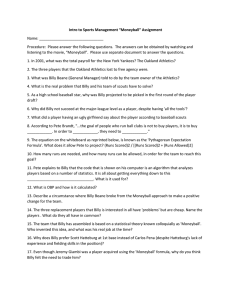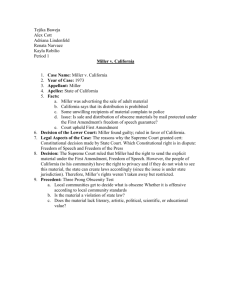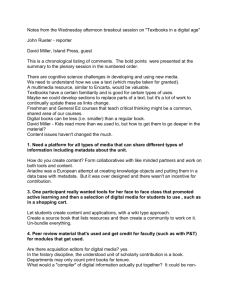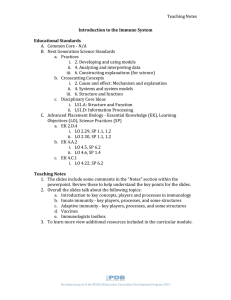Konja 1 Mario Konja Katrina Newsom English 1020 26 Feburary
advertisement
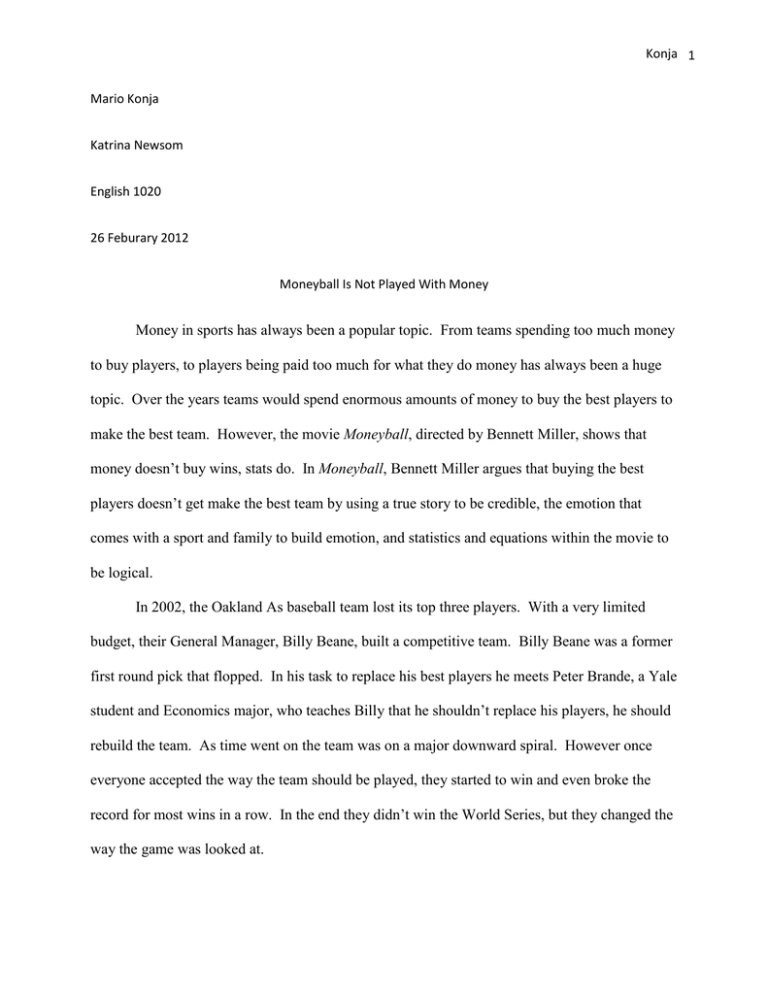
Konja 1 Mario Konja Katrina Newsom English 1020 26 Feburary 2012 Moneyball Is Not Played With Money Money in sports has always been a popular topic. From teams spending too much money to buy players, to players being paid too much for what they do money has always been a huge topic. Over the years teams would spend enormous amounts of money to buy the best players to make the best team. However, the movie Moneyball, directed by Bennett Miller, shows that money doesn’t buy wins, stats do. In Moneyball, Bennett Miller argues that buying the best players doesn’t get make the best team by using a true story to be credible, the emotion that comes with a sport and family to build emotion, and statistics and equations within the movie to be logical. In 2002, the Oakland As baseball team lost its top three players. With a very limited budget, their General Manager, Billy Beane, built a competitive team. Billy Beane was a former first round pick that flopped. In his task to replace his best players he meets Peter Brande, a Yale student and Economics major, who teaches Billy that he shouldn’t replace his players, he should rebuild the team. As time went on the team was on a major downward spiral. However once everyone accepted the way the team should be played, they started to win and even broke the record for most wins in a row. In the end they didn’t win the World Series, but they changed the way the game was looked at. Konja 2 The movie Moneyball is based on a true story. Miller took advantage of this and used real newreports, clips, and audio from the games and sports segments about the team around those times to help build his ethos. One example is during the times when the team was not performing up to their statistical standards Miller played audio from news reports and sportscasts say things like, “The idea of Moneyball was a good idea and a good try, but it just didn’t work. You can’t base the game off numbers. Baseball you have run, bunt, steal, and more only a coach and scout can figure these things out.” (Pitt and Hill) Another example was during their winning streak. During the streak Miller showed game clips and real game audio. He showed score lines of the games that they won. Also, he showed highlights and clips from games during this point in the film. He would show people getting walked at the plate and some basic runs scored in the games. One last example of him using real game footage was the last game to break the record for longest win streak. At the end of the game a player by the name Scott Hatteburg got up to the plate for the last out of the game. When Hatteburg hit the ball Miller used the real footage of the game to show the homerun and show the team’s reaction to the win. This showed the audience proof that what is being told actually happened making it a credible movie. All these things helped build up Bennett Miller’s ethos. Baseball is an emotional sport in the United States of America. It is such a special sport it is even nicknamed “America’s Past Time”. Miller uses the passion of a sport to help engage the audience and try to make them feel certain emotions. One example is when they fast forward the first part of the season. Here Miller plays a lot of negative audio about the team being unsuccessful and he also shows footage of the team being unsuccessful, he really emphasizes the world “lost” as well. He attempts to engage the audience and make them believe that their favorite team is the Oakland As so that they can understand how the fans really felt, which in this Konja point of the movie was a bit of disappointment and sadness. Later on the team starts to win and Miller uses the same style to again in an attempt to engage the audience. He plays inspiring music and audio of the team successes, footage of the team winning is also shown, the word “won” or “win” appear to show a lot of emphasis. This time he is trying to make the audience have a feeling of hope and try to make them think that the Oakland As can pull off some type of miracle. Another form of pathos used was the use of his ex-wife and his daughter. To show that Billy really believed that the system would work he put his job in jeopardy. During the time when the team was not being very productive his daughter would ask him if he was going to lose his job. Bringing his family into the movie Miller makes an attempt to bring an emotion to the audience. He hopes that the audience will start to feel that if the new budget system doesn’t work then his life is ruined. These emotions that Miller tries to bring upon the audience really highlight the fact that teams do not need a big budget to be a winning team, you just need the right mix of players. Miller then hopes the audience then starts to believe the system and that it works. This is how Miller uses the passion of sports and pathos. The use of statistics in the movie really shows the logic of the “Moneyball” system. In the movie Miller uses player stats and equations to further his point. Using the character Peter Brande, Miller explains the “Moneyball” system. One example is when Peter and Billy first interact. Peter then tells Billy his thoughts on the game: There is an epidemic failure within the game to understand what is really happening, and this leads people who run Major League Baseball teams to misjudge their players and mismanage their teams…People who run ball clubs 3 Konja 4 they think in terms of buying players. Your goal shouldn’t be to buy players; it should be to buy wins, and to buy wins you need to buy runs. Later, they talk about equations like Runs Scored2/( Runs Scored2 + Runs Allowed2) this particular equation was for a teams win percentage. During the first meeting with Peter as the new Assistant General Manager the main stat talked about was the players On Base Percentage. The three top players that left had a combined On Base Percentage of 1092, so they had to find 3 players whose average On Base Percentage was a third of that, which is 364. The new pitcher Billy picked up was also based on stats. The pitchers name was Chad Bradford, and Bradford struck out his opponent two thirds of the time, yet nobody signed him. All these stats played a huge role in showing how the system works. Miller also shows that each stat is somehow related. For example, you need runs to win, and you a certain amount of runs to win a certain amount of games, and to get those runs you need your players to get on base. In the movie Peter and Billy talk to the players to change the way they play. Some examples were that they told the players to never steal because stealing means an out. Billy would say, “I pay you to get on first, not get thrown out at second.” Another example was that they tell the players to never bunt. To Billy and Peter a bunt was an out. This is how the stats and equations played a part in the logos of the movie. Miller’s use of a true story, the emotions involving a sport and family, and use of logic through stats and equations advances his idea that buying the best players doesn’t make the best team. The true story of Billy Beane and the Oakland As shows how credible of a source it is. A movie based on a true story is usually very close to what really happened. The use of the emotion in sports helped trigger certain emotions towards the audience. As well as the use of family, this also helped engage the audience and bring up certain emotions. Last, the use of Konja 5 statistics and equations in the movie to show some of the logic in his argument. All these factors prove to be effective in his argument. Konja Works Cited Moneyball. Dir. Bennett Miller. Perf. Brad Pitt and Jonah Hill. Columbia Pictures 2011. DVD.

